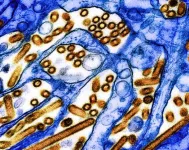(Press-News.org) Disparities in cardiovascular disease outcomes between urban and rural areas continue to widen, yet nearly half of U.S. counties do not have a practicing cardiologist. According to a new analysis published in JACC, the flagship journal of the American College of Cardiology, these counties tend to be more rural and socioeconomically disadvantaged, with a greater burden of cardiovascular disease, thus highlighting deep geographic disparity in access to cardiovascular care.
“While cardiologists are not the only determinants of cardiovascular outcomes, the lack of access to cardiologists in areas with greater prevalence of heart disease and mortality is incredibly concerning,” said Haider J. Warraich, MD, director of the heart failure program at VA Boston Healthcare, associate physician at Brigham and Women’s Hospital in Boston and the study’s senior author.
Upon analyzing all 3,143 U.S. counties, it was determined that 1,454 counties (46.3%) with 22 million residents had no cardiologists while the other 1,689 counties each had 24 cardiologists on average.
Other findings included:
86.2% of rural counties had no cardiologists.
Average round-trip distance to nearest cardiologist was 16.3 miles vs 87.1 miles in counties with and without cardiologists.
Compared to counties with cardiologists, counties without cardiologists had:
31% higher cardiovascular risk index
Greater prevalence of all risk factors
Higher age-adjusted cardiovascular mortality rates
One-year shorter life expectancy on average
Counties without cardiologists were more likely to be rural with lower household incomes, greater uninsured levels, worse access to healthy food and primary care clinicians, and experienced more preventable hospitalizations. Of all the racial-ethnic groups examined, Native Americans were the most likely to be living in a county without a cardiologist. Counties lacking a cardiologist were unlikely to be on either coast of the U.S. and those in the South had the highest cardiovascular risk index.
“Our findings really highlight the critical need to find ways to mitigate deep disparities to improve cardiovascular disease outcomes for Americans living in rural and disadvantaged areas,” Warraich said. “Policy reforms, such as financial incentives to clinicians to practice in areas with marginal access or better leveraging telemedicine are potential options. The integration and coordination of cardiovascular care—especially with regard to prevention and risk modification—with the primary care is crucial.”
According to the researchers, broader policy interventions to widen broadband access and increase digital literacy, increase access to adequate health insurance coverage and reducing prevalence of modifiable risk factors would also have a sustainable impact.
“The findings of this study are both enlightening and alarming, shedding light on the severe geographic disparities in access to cardiovascular care across the United States,” said JACC Editor-in-Chief Harlan M. Krumholz, MD, SM, FACC. “This study underscores the urgent need for policy reforms and innovative solutions, such as financial incentives for clinicians and the expanded use of telemedicine, to bridge this gap. Ensuring equitable access to cardiovascular care is a crucial step towards improving overall public health outcomes and reducing preventable cardiovascular mortality.”
The ACC aims to achieve a culture of equitable cardiovascular care and heart health for all. ACC’s health equity strategy uses advocacy, education and science to acknowledge social determinants of health and eliminate disparities. Recently, the ACC held a webinar on effective solutions and interventions to improve cardiovascular care in indigenous communities.
The ACC also developed a Health Equity Heat Map, a population health map that uses location-based metrics to examine the demographics of local communities across the U.S. The map enables health care professionals to understand the scope of cardiovascular-related issues in the populations they serve.
The American College of Cardiology (ACC) is the global leader in transforming cardiovascular care and improving heart health for all. As the preeminent source of professional medical education for the entire cardiovascular care team since 1949, ACC credentials cardiovascular professionals in over 140 countries who meet stringent qualifications and leads in the formation of health policy, standards and guidelines. Through its world-renowned family of JACC Journals, NCDR registries, ACC Accreditation Services, global network of Member Sections, CardioSmart patient resources and more, the College is committed to ensuring a world where science, knowledge and innovation optimize patient care and outcomes. Learn more at www.ACC.org or follow @ACCinTouch.
The ACC’s JACC Journals rank among the top cardiovascular journals in the world for scientific impact. The flagship journal, JACC — and specialty journals consisting of JACC: Advances, JACC: Asia, JACC: Basic to Translational Science, JACC: CardioOncology, JACC: Cardiovascular Imaging, JACC: Cardiovascular Interventions, JACC: Case Reports, JACC: Clinical Electrophysiology and JACC: Heart Failure — pride themselves on publishing the top peer-reviewed research on all aspects of cardiovascular disease. Learn more at JACC.org.
###
END
Hospital-level care provided in a patient’s own home is appealing to a majority of people for its convenience, comfort and effectiveness, according to a USC Schaeffer Center study.
The study, published in JAMA, found that most survey respondents felt they would recover faster if cared for at home, rather than in the hospital, and that they felt safe being treated at home.
Researchers say their study provides important insights about patient and family preferences as policymakers weigh whether to extend ...
KEY TAKEAWAYS
In a study involving 50,000+ individuals from around the world, higher gut levels of Blastocystis, a single-celled organism commonly found in the digestive system, were linked to more favorable indicators of health.
People with a healthy diet had higher levels of Blastocystis.
The study, which was conducted by an international team led by investigators at Massachusetts General Hospital, suggests that Blastocystis may play a beneficial role in how diet impacts health.
In an analysis of more than 50,000 individuals from around the world, carriers of gut Blastocystis, a single-celled organism that has been ...
David Luther, Associate Professor, Biology, received funding for the project: “Identifying Road Segments that Bisect Predicted Movement Corridors for Small Priority Species in Virginia.”
The purpose of this study is to advance the work of the legislated Wildlife Corridor Action Plan (WCAP) and meet the intent of an awarded Federal Highway Administration (FHWA) grant by identifying road segments that may pose a high risk or impede movement of select small terrestrial and semiaquatic animal species that are ...
ITHACA, N.Y. - Organizations using AI to monitor employees’ behavior and productivity can expect them to complain more, be less productive and want to quit more – unless the technology can be framed as supporting their development, Cornell University research finds.
Surveillance tools cause people to feel a greater loss of autonomy than oversight by humans, according to the research. Businesses and other organizations using the fast-changing technologies to evaluate employee behaviors should consider their unintended consequences, which may prompt resistance and hurt performance, the researchers say. They also suggest an opportunity to win buy-in, ...
Novel liquid biopsy methodology enables the monitoring of disease evolution in patients with metastatic prostate cancer
Extracellular vesicles shed by prostate cancer cells to the bloodstream contain tumor-derived material that can be used as biomarkers of therapy response and resistance in patients with metastatic disease.
Published today in the journal Cancer Cell, results of a VHIO-led study show that a newly developed liquid biopsy-based approach can monitor tumor gene expression through RNA contained ...
Zachary Schrag, Professor, History and Art History, College of Humanities and Social Sciences (CHSS), received funding for the project: “Rail Against Sprawl: A History of the Dulles Corridor Metrorail Project.”
Schrag said, “I am writing the history of the Dulles Corridor Metrorail Project, among the nation’s most ambitious efforts to reshape daily transportation choices. After decades of planning and construction, the project was completed in 2022, extending the Washington ...
A new study led by researchers at McLean Hospital and Harvard Medical School, in collaboration with researchers from Massachusetts General Hospital and Cambridge Health Alliance, has uncovered concerning disparities in boarding rates of children and adolescents with severe mental health symptoms in emergency departments.
When reviewing more than 4,900 boarding episodes of youth under 17 years old in Massachusetts over an 18-month period, the researchers found there were numerous racial and gender disparities: Black youth were less likely to be admitted to inpatient psychiatric care than White youth. Additionally, transgender and nonbinary youth experienced ...
While H5N1 avian influenza virus taken from infected cow’s milk makes mice and ferrets sick when dripped into their noses, airborne transmission of the virus between ferrets — a common model for human transmission — appears to be limited.
These and other new findings about the strain of H5N1 circulating among North American dairy cattle this year come from a set of laboratory experiments led by University of Wisconsin–Madison researchers, reported today in the journal Nature. Together, they suggest that exposure to raw milk infected with the currently circulating virus poses a real risk of infecting humans, but that the virus may not ...
WHAT:
A series of experiments with highly pathogenic H5N1 avian influenza (HPAI H5N1) viruses circulating in infected U.S. dairy cattle found that viruses derived from lactating dairy cattle induced severe disease in mice and ferrets when administered via intranasal inoculation. The virus from the H5N1-infected cows bound to both avian (bird) and human-type cellular receptors, but, importantly, did not transmit efficiently among ferrets exposed via respiratory droplets. The findings, published in Nature, suggest that bovine (cow) ...
Researchers from Trinity College Dublin have taken a leap forward in understanding how we might fight back against the potentially deadly MRSA bacterium. They have shown in an animal model that targeting a key suppressive immune molecule (IL-10) during the delivery of a vaccine improves the ability of the vaccine to protect against infection.
The bacterium Staphylococcus aureus is one of the leading causes of community- and hospital-acquired bacterial infection, and is associated with over one million deaths worldwide each year. Unfortunately, antibiotics are becoming increasingly less effective against this bacterium with the antibiotic-resistant ...


